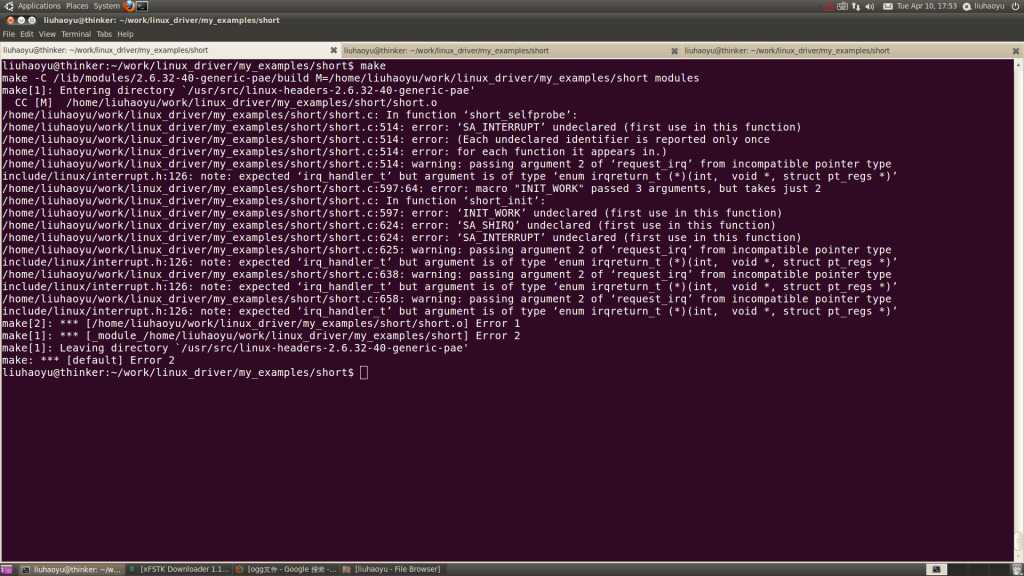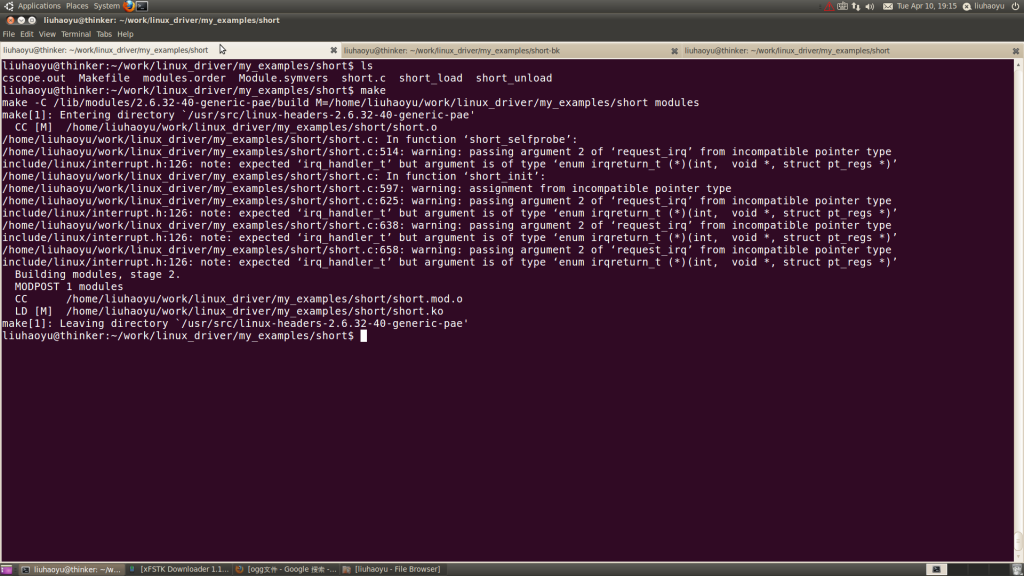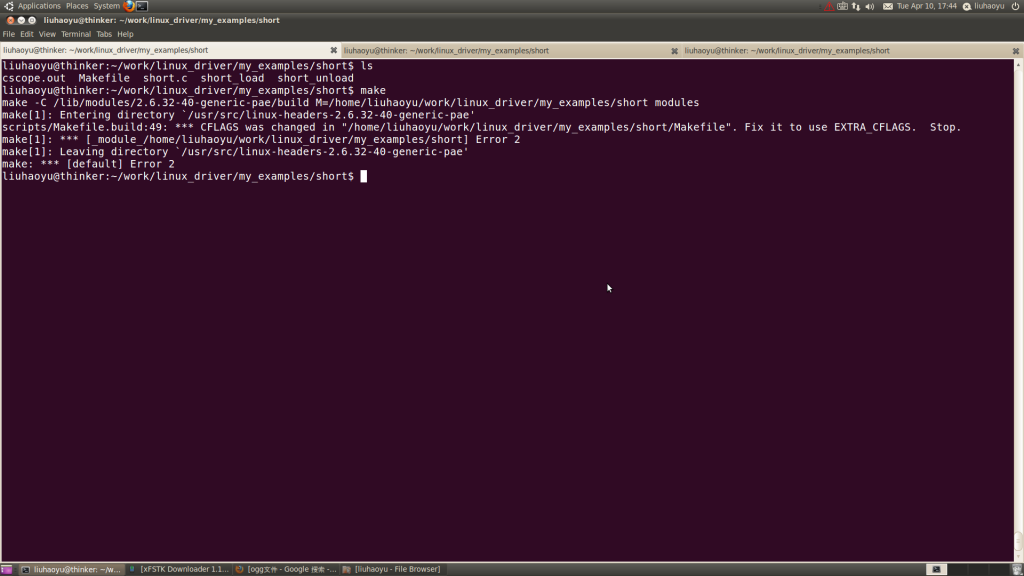LDD3源码分析之与硬件通信&中断处理
来源:互联网 发布:软件测试行业方向 编辑:程序博客网 时间:2024/04/18 23:38
作者:刘昊昱
博客:http://blog.csdn.net/liuhaoyutz
编译环境:Ubuntu 10.10
内核版本:2.6.32-38-generic-pae
LDD3源码路径:examples/short/
本分析LDD3第9和第10章的示例代码short。short涉及的主要知识点有通过I/O端口或I/O内存操作设备寄存器及设备内存,注册中断处理函数处理中断。本来第9和第10章的代码应该分别进行讨论,但是因为short的代码相互关联比较紧密,所以这里放在同一篇文章中分析。 一、short模块编译在新的内核下,编译short模块时,会遇到一些问题,这里列出遇到的问题及解决方法。第一次make时,出现如下错误:修改Makefile的第12,13,35行,将CFLAGS改为EXTRA_CFLAGS,即可解决这个问题。再次make,会出现如下错误:修改short.c,把第24行#include <linux/config.h>屏蔽掉。再次编译出现如下问题:
这是因为SA_INTERRUPT和SA_SHIRQ标志在新内核中发生了变化,SA_INTERRUPT标志已经不存在了,SA_SHIRQ标志位变为IRQF_SHARED。所以做以下修改:514,638,658行把flag标志设置为0,624行把flag设置为IRQF_SHARED,修改完成后,再次编译,出现如下错误:
修改597行为INIT_WORK(&short_wq, (void (*)(struct work_struct *)) short_do_tasklet);再次make,编译通过,但还有一些警告信息如下:
这是因为在新的内核版本中中断处理函数的原型只有两个参数,而在2.6.10中有三个参数,这里只要把相应中断处理函数的第三个参数去掉即可,修改后的函数原型如下:494irqreturn_t short_probing(int irq, void *dev_id)443irqreturn_t short_sh_interrupt(int irq, void *dev_id)431irqreturn_t short_tl_interrupt(int irq, void *dev_id)413irqreturn_t short_wq_interrupt(int irq, void *dev_id)336irqreturn_t short_interrupt(int irq, void *dev_id)再次编译,通过。
二、short模块初始化先来看short模块初始化函数:548int short_init(void)549{550 int result;551552 /*553 * first, sort out the base/short_base ambiguity: we'd better554 * use short_base in the code, for clarity, but allow setting555 * just "base" at load time. Same for "irq".556 */557 short_base = base;558 short_irq = irq;559560 /* Get our needed resources. */561 if (!use_mem) {562 if (! request_region(short_base, SHORT_NR_PORTS, "short")) {563 printk(KERN_INFO "short: can't get I/O port address 0x%lx\n",564 short_base);565 return -ENODEV;566 }567568 } else {569 if (! request_mem_region(short_base, SHORT_NR_PORTS, "short")) {570 printk(KERN_INFO "short: can't get I/O mem address 0x%lx\n",571 short_base);572 return -ENODEV;573 }574575 /* also, ioremap it */576 short_base = (unsigned long) ioremap(short_base, SHORT_NR_PORTS);577 /* Hmm... we should check the return value */578 }579 /* Here we register our device - should not fail thereafter */580 result = register_chrdev(major, "short", &short_fops);581 if (result < 0) {582 printk(KERN_INFO "short: can't get major number\n");583 release_region(short_base,SHORT_NR_PORTS); /* FIXME - use-mem case? */584 return result;585 }586 if (major == 0) major = result; /* dynamic */587588 short_buffer = __get_free_pages(GFP_KERNEL,0); /* never fails */ /* FIXME */589 short_head = short_tail = short_buffer;590591 /*592 * Fill the workqueue structure, used for the bottom half handler.593 * The cast is there to prevent warnings about the type of the594 * (unused) argument.595 */596 /* this line is in short_init() */597 INIT_WORK(&short_wq, (void (*)(void *)) short_do_tasklet, NULL);598599 /*600 * Now we deal with the interrupt: either kernel-based601 * autodetection, DIY detection or default number602 */603604 if (short_irq < 0 && probe == 1)605 short_kernelprobe();606607 if (short_irq < 0 && probe == 2)608 short_selfprobe();609610 if (short_irq < 0) /* not yet specified: force the default on */611 switch(short_base) {612 case 0x378: short_irq = 7; break;613 case 0x278: short_irq = 2; break;614 case 0x3bc: short_irq = 5; break;615 }616617 /*618 * If shared has been specified, installed the shared handler619 * instead of the normal one. Do it first, before a -EBUSY will620 * force short_irq to -1.621 */622 if (short_irq >= 0 && share > 0) {623 result = request_irq(short_irq, short_sh_interrupt,624 SA_SHIRQ | SA_INTERRUPT,"short",625 short_sh_interrupt);626 if (result) {627 printk(KERN_INFO "short: can't get assigned irq %i\n", short_irq);628 short_irq = -1;629 }630 else { /* actually enable it -- assume this *is* a parallel port */631 outb(0x10, short_base+2);632 }633 return 0; /* the rest of the function only installs handlers */634 }635636 if (short_irq >= 0) {637 result = request_irq(short_irq, short_interrupt,638 SA_INTERRUPT, "short", NULL);639 if (result) {640 printk(KERN_INFO "short: can't get assigned irq %i\n",641 short_irq);642 short_irq = -1;643 }644 else { /* actually enable it -- assume this *is* a parallel port */645 outb(0x10,short_base+2);646 }647 }648649 /*650 * Ok, now change the interrupt handler if using top/bottom halves651 * has been requested652 */653 if (short_irq >= 0 && (wq + tasklet) > 0) {654 free_irq(short_irq,NULL);655 result = request_irq(short_irq,656 tasklet ? short_tl_interrupt :657 short_wq_interrupt,658 SA_INTERRUPT,"short-bh", NULL);659 if (result) {660 printk(KERN_INFO "short-bh: can't get assigned irq %i\n",661 short_irq);662 short_irq = -1;663 }664 }665666 return 0;667}
561 - 567行,如果指定使用I/O端口,则调用request_region函数分配I/O端口,这里代码指定要分配从short_base开始的SHORT_NR_PORTS个即8个端口。
568 - 578行,如果指定使用I/O内存,则调用request_mem_region函数分配从short_base开始的SHORT_NR_PORTS个即8个字节的I/O内存。分配I/O内存并不是在使用这些内存之前需要完成的唯一步骤,我们必须首先通过ioremap函数建立映射。ioremap返回用来访问指定物理内存的虚拟地址。580 - 586行,注册字符设备short", 其文件操作函数集是short_fops。588行,调用__get_free_pages(GFP_KERNEL,0)分配一个页面保存在 short_buffer中。597行,调用INIT_WORK初始化一个工作,将来用作中断处理函数的下半部。604 - 605行,如果short_irq<0并且probe等于1,则调用short_kernelprobe函数由内核探测中断号。该函数的实现我们后面分析。607 - 608行,如果short_irq<0并且probe等于2,则调用short_selfprobe函数自己手动探测中断号,该函数的实现我们后面分析。610 - 615行,如果探测没有成功,根据端口地址,强制指定中断号。622 - 634行,以共享中断的方式注册中断处理函数。需要注意的是631行调用outb(0x10, short_base+2),将并口2号寄存器的第4位置为1,表示启动并口中断报告。636 - 647行,以非共享中断的方式注册中断处理函数。653 - 664行,以上半部/下半部的方式注册中断处理函数。下面我们来看short_kernelprobe函数如何实现由内核自动探测中断号的:466void short_kernelprobe(void)467{468 int count = 0;469 do {470 unsigned long mask;471472 mask = probe_irq_on();473 outb_p(0x10,short_base+2); /* enable reporting */474 outb_p(0x00,short_base); /* clear the bit */475 outb_p(0xFF,short_base); /* set the bit: interrupt! */476 outb_p(0x00,short_base+2); /* disable reporting */477 udelay(5); /* give it some time */478 short_irq = probe_irq_off(mask);479480 if (short_irq == 0) { /* none of them? */481 printk(KERN_INFO "short: no irq reported by probe\n");482 short_irq = -1;483 }484 /*485 * if more than one line has been activated, the result is486 * negative. We should service the interrupt (no need for lpt port)487 * and loop over again. Loop at most five times, then give up488 */489 } while (short_irq < 0 && count++ < 5);490 if (short_irq < 0)491 printk("short: probe failed %i times, giving up\n", count);492}
Linux内核提供了探测可用中断号的接口,但这种接口只能在非共享中断模式下使用。内核提供的接口由两个函数组成:
unsigned long probe_irq_on(void);这个函数返回一个未分配中断的位掩码,驱动程序必须保存返回的位掩码,并将它传递给probe_irq_off函数。调用probe_irq_on函数之后,驱动程序要安排设备产生至少一次中断。int probe_irq_off(unsigned long);在请求设备产生中断之后,驱动程序要调用这个函数,并将前面probe_irq_on返回的位掩码作为参数传递给它。probe_irq_off返回probe_irq_on之后发生的中断编号。如果没有中断发生,就返回0。如果产生了多次中断,出现了二义性,就返回负数。使用内核提供的接口探测中断号时,需要注意在调用probe_irq_on之后启用设备中断,在调用probe_irq_off之前禁用中断。另外,在probe_irq_off之后,需要处理设备上待处理的中断。472行,调用probe_irq_on函数。473行,将2号端口的第4位(0x10)设置为1,启用中断。474行,将0号端口清0。475行,将0号端口置1,触发中断。476行,将2号端口的第4位(0x10)设置为0,禁用中断。477行,延时一会,以保证中断的传递时间。478行,调用probe_irq_off函数,并把472行probe_irq_on函数返回的位掩码传递给它。480行,probe_irq_off函数返回0,说明没有中断发生。489行,probe_irq_off函数返回负值,说明发生了不止一个中断,需要重新探测,这里限定最多探测5次。下面我们看short_selfprobe函数如何实现DIY探测中断号:501void short_selfprobe(void)502{503 int trials[] = {3, 5, 7, 9, 0};504 int tried[] = {0, 0, 0, 0, 0};505 int i, count = 0;506507 /*508 * install the probing handler for all possible lines. Remember509 * the result (0 for success, or -EBUSY) in order to only free510 * what has been acquired511 */512 for (i = 0; trials[i]; i++)513 tried[i] = request_irq(trials[i], short_probing,514 SA_INTERRUPT, "short probe", NULL);515516 do {517 short_irq = 0; /* none got, yet */518 outb_p(0x10,short_base+2); /* enable */519 outb_p(0x00,short_base);520 outb_p(0xFF,short_base); /* toggle the bit */521 outb_p(0x00,short_base+2); /* disable */522 udelay(5); /* give it some time */523524 /* the value has been set by the handler */525 if (short_irq == 0) { /* none of them? */526 printk(KERN_INFO "short: no irq reported by probe\n");527 }528 /*529 * If more than one line has been activated, the result is530 * negative. We should service the interrupt (but the lpt port531 * doesn't need it) and loop over again. Do it at most 5 times532 */533 } while (short_irq <=0 && count++ < 5);534535 /* end of loop, uninstall the handler */536 for (i = 0; trials[i]; i++)537 if (tried[i] == 0)538 free_irq(trials[i], NULL);539540 if (short_irq < 0)541 printk("short: probe failed %i times, giving up\n", count);542}494irqreturn_t short_probing(int irq, void *dev_id, struct pt_regs *regs)495{496 if (short_irq == 0) short_irq = irq; /* found */497 if (short_irq != irq) short_irq = -irq; /* ambiguous */498 return IRQ_HANDLED;499}
DIY探测与内核自动探测的原理是一样的:先启动所有未被占用的中断,然后观察会发生什么。但是,我们要充分发挥对具体设备的了解。通常,设备能使用3或4个IRQ号中的一个来进行配置,探测这些IRQ号,使我们能不必测试所有可能的IRQ就能检测到正确的IRQ号。
并口允许用户选择的IRQ号有3,5,7,9,所以在short中,我们探测这几个中断号。503行,trials数组列出了以0作为结束标志的需要测试的IRQ。504行,tried数组用来记录哪个中断号被short驱动程序注册了。512 - 514行,循环trials数组,为每个要探测的中断号注册中断处理函数short_probing。注意, request_irq函数如果注册成功,返回0保存在tried[i]中。517 - 522行,触发中断,引起short_probing函数的执行。在short_probing函数中,将发生中断的中断号保存在short_irq中,如果发生多次中断,将设置short_irq值为负数。525 - 527行,如果short_irq的值为0,说明没有发生中断。533行,如果short_irq的值小于或等于0,则重新探测,最多探测5次。536 - 538行,释放IRQ。完成自动探测或DIY探测后,我们回到short_init函数:610 - 615行,short_irq小于0,说明没有探测到中断号,short根据端口地址,强制指定默认中断号。622 - 634行,如果(short_irq >= 0 && share > 0),则以共享中断方式注册中断处理函数short_sh_interrupt。其中,631行使用outb(0x10, short_base + 2)启动中断报告。636 - 647行,如果没有指定共享中断,则以非共享中断方式注册中断处理函数short_interrupt。其中645行outb(0x10,short_base+2)启动中断报告。653 - 663行,注册以顶半部/底半部的方式执行中断处理。如果使用tasklet,对应的中断处理函数是short_tl_interrupt,如果使用工作队列,对应的中断处理函数是short_wq_interrupt。按照在short_init中出现的顺序,下面我们要看short_sh_interrupt函数了:443irqreturn_t short_sh_interrupt(int irq, void *dev_id, struct pt_regs *regs)444{445 int value, written;446 struct timeval tv;447448 /* If it wasn't short, return immediately */449 value = inb(short_base);450 if (!(value & 0x80))451 return IRQ_NONE;452453 /* clear the interrupting bit */454 outb(value & 0x7F, short_base);455456 /* the rest is unchanged */457458 do_gettimeofday(&tv);459 written = sprintf((char *)short_head,"%08u.%06u\n",460 (int)(tv.tv_sec % 100000000), (int)(tv.tv_usec));461 short_incr_bp(&short_head, written);462 wake_up_interruptible(&short_queue); /* awake any reading process */463 return IRQ_HANDLED;464} 93/* 94 * Atomicly increment an index into short_buffer 95 */ 96static inline void short_incr_bp(volatile unsigned long *index, int delta) 97{ 98 unsigned long new = *index + delta; 99 barrier(); /* Don't optimize these two together */100 *index = (new >= (short_buffer + PAGE_SIZE)) ? short_buffer : new;101}
注册共享的中断处理程序时,request_irq函数的flag参数必须指定SA_SHIRQ标志,同时dev_id参数必须是唯一的,任何指向模块地址空间的指针都可以使用,但是dev_id不能设置为NULL。
注销共享中断处理程序同样使用free_irq,传递dev_id参数用来从该中断的共享处理程序列表中选择指定的处理程序。这也是dev_id必须唯一的原因。内核为每个中断维护了一个共享处理程序列表,这些处理程序的dev_id各不相同,就像是设备的签名。当请求一个共享中断时,如果满足下面条件之一,request_irq就能成功:1.中断号空闲。2.任何已经注册了该中断号的处理例程也标识了中断号是共享的。当共享的中断发生时,内核会调用每一个已经注册的中断处理函数,因此,一个共享中断的中断处理函数必须能识别属于自己的中断,如果不是自己的设备被中断,应该迅速退出。449 - 451行,读取端口short_base,如果ACK位为1,则报告的中断就是发送给short的。如果为0,则是发给其它中断处理函数的,此时short_sh_interrupt应该立即退出。454行,清除ACK位。458行,获取当前时间。459 - 460行,将时间信息保存在short_head中,在模块初始化函数short_init中,有如下语句:588 short_buffer = __get_free_pages(GFP_KERNEL,0); /* never fails */ /* FIXME */589 short_head = short_tail = short_buffer;所以short_head指向缓冲区short_buffer的空闲起始位置。461行,调用short_incr_bp函数更新空闲缓冲区头指针short_head位置。462行,唤醒等待队列short_queue上的进程。如果不是使用共享中断方式,在short_init函数中注册的中断处理函数是short_interrupt,该函数内容如下:336irqreturn_t short_interrupt(int irq, void *dev_id, struct pt_regs *regs)337{338 struct timeval tv;339 int written;340341 do_gettimeofday(&tv);342343 /* Write a 16 byte record. Assume PAGE_SIZE is a multiple of 16 */344 written = sprintf((char *)short_head,"%08u.%06u\n",345 (int)(tv.tv_sec % 100000000), (int)(tv.tv_usec));346 BUG_ON(written != 16);347 short_incr_bp(&short_head, written);348 wake_up_interruptible(&short_queue); /* awake any reading process */349 return IRQ_HANDLED;350}
short_interrupt函数的内容和共享中断处理函数short_sh_interrupt的后半部分完全一样,这里不多解释,请参考对short_sh_interrupt函数的分析。
如果指定以顶半部/底半部的方式执行中断处理,在short_init函数中重新注册了中断处理函数,如果采用tasklet,则顶半部是short_tl_interrupt,如果采用工作队列,则顶半部是short_wq_interrupt。这两个函数列出如下:413irqreturn_t short_wq_interrupt(int irq, void *dev_id, struct pt_regs *regs)414{415 /* Grab the current time information. */416 do_gettimeofday((struct timeval *) tv_head);417 short_incr_tv(&tv_head);418419 /* Queue the bh. Don't worry about multiple enqueueing */420 schedule_work(&short_wq);421422 short_wq_count++; /* record that an interrupt arrived */423 return IRQ_HANDLED;424}425426427/*428 * Tasklet top half429 */430431irqreturn_t short_tl_interrupt(int irq, void *dev_id, struct pt_regs *regs)432{433 do_gettimeofday((struct timeval *) tv_head); /* cast to stop 'volatile' warning */434 short_incr_tv(&tv_head);435 tasklet_schedule(&short_tasklet);436 short_wq_count++; /* record that an interrupt arrived */437 return IRQ_HANDLED;438}
在顶半部中,取得当前时间后,调用short_incr_tv函数将时间保存在tv_data数组中,然后调度tasklet或工作稍后执行:
372static inline void short_incr_tv(volatile struct timeval **tvp)373{374 if (*tvp == (tv_data + NR_TIMEVAL - 1))375 *tvp = tv_data; /* Wrap */376 else377 (*tvp)++;378}
short_incr_tv函数用到的几个变量定义如下:
357#define NR_TIMEVAL 512 /* length of the array of time values */358359struct timeval tv_data[NR_TIMEVAL]; /* too lazy to allocate it */360volatile struct timeval *tv_head=tv_data;361volatile struct timeval *tv_tail=tv_data;
工作short_wq的初始化在short_init函数中:
597 INIT_WORK(&short_wq, (void (*)(void *)) short_do_tasklet, NULL);
tasklet short_tasklet定义在第91行,如下:
91DECLARE_TASKLET(short_tasklet, short_do_tasklet, 0);
由此可见,工作队列和tasklet的处理函数都是short_do_tasklet,它就是所谓的底半部函数:
382void short_do_tasklet (unsigned long unused)383{384 int savecount = short_wq_count, written;385 short_wq_count = 0; /* we have already been removed from the queue */386 /*387 * The bottom half reads the tv array, filled by the top half,388 * and prints it to the circular text buffer, which is then consumed389 * by reading processes390 */391392 /* First write the number of interrupts that occurred before this bh */393 written = sprintf((char *)short_head,"bh after %6i\n",savecount);394 short_incr_bp(&short_head, written);395396 /*397 * Then, write the time values. Write exactly 16 bytes at a time,398 * so it aligns with PAGE_SIZE399 */400401 do {402 written = sprintf((char *)short_head,"%08u.%06u\n",403 (int)(tv_tail->tv_sec % 100000000),404 (int)(tv_tail->tv_usec));405 short_incr_bp(&short_head, written);406 short_incr_tv(&tv_tail);407 } while (tv_tail != tv_head);408409 wake_up_interruptible(&short_queue); /* awake any reading process */410}
在底半部函数中,把时间信息从tv_data数组中取出来,写到short_buffer缓冲区中,然后唤醒等待队列short_queue上的进程。这些进程将从short_buffer中读取时间信息。
三、文件操作函数分析完了模块初始化函数,我们可以看设备文件操作函数了,文件操作函数集是short_fops:270struct file_operations short_fops = {271 .owner = THIS_MODULE,272 .read = short_read,273 .write = short_write,274 .poll = short_poll,275 .open = short_open,276 .release = short_release,277};
先看short_open函数:
114int short_open (struct inode *inode, struct file *filp)115{116 extern struct file_operations short_i_fops;117118 if (iminor (inode) & 0x80)119 filp->f_op = &short_i_fops; /* the interrupt-driven node */120 return 0;121}
118 - 119行,如果次设备号的第8位为1,重新设置文件操作函数集为short_i_fops。理解这样的设置可以看一下ldd3自带的short_load脚本,该脚本创建的设备节点/dev/shortint和/dev/shortprint的次设备号分别为128和129,如果对这两个节点进行操作,采用short_i_fops,即使用中断。对其它节点的操作,使用非中断操作。
328struct file_operations short_i_fops = {329 .owner = THIS_MODULE,330 .read = short_i_read,331 .write = short_i_write,332 .open = short_open,333 .release = short_release,334};
下面看short_read的实现:
190ssize_t short_read(struct file *filp, char __user *buf, size_t count, loff_t *f_pos)191{192 return do_short_read(filp->f_dentry->d_inode, filp, buf, count, f_pos);193} 134ssize_t do_short_read (struct inode *inode, struct file *filp, char __user *buf,135 size_t count, loff_t *f_pos)136{137 int retval = count, minor = iminor (inode);138 unsigned long port = short_base + (minor&0x0f);139 void *address = (void *) short_base + (minor&0x0f);140 int mode = (minor&0x70) >> 4;141 unsigned char *kbuf = kmalloc(count, GFP_KERNEL), *ptr;142143 if (!kbuf)144 return -ENOMEM;145 ptr = kbuf;146147 if (use_mem)148 mode = SHORT_MEMORY;149150 switch(mode) {151 case SHORT_STRING:152 insb(port, ptr, count);153 rmb();154 break;155156 case SHORT_DEFAULT:157 while (count--) {158 *(ptr++) = inb(port);159 rmb();160 }161 break;162163 case SHORT_MEMORY:164 while (count--) {165 *ptr++ = ioread8(address);166 rmb();167 }168 break; 169 case SHORT_PAUSE:170 while (count--) {171 *(ptr++) = inb_p(port);172 rmb();173 }174 break;175176 default: /* no more modes defined by now */177 retval = -EINVAL;178 break;179 }180 if ((retval > 0) && copy_to_user(buf, kbuf, retval))181 retval = -EFAULT;182 kfree(kbuf);183 return retval;184}
138行,确定要访问的端口。
139行,确定要访问的内存地址。注意,对一个设备节点来说,要么是采用I/O端口,要么是采用I/O内存,不可能两个同时用,所以137和138行只有一个起作用,这里只是为减少程序代码而写在一起。理解这两句话,需要联系模块初始化函数short_init中的如下代码:560 /* Get our needed resources. */561 if (!use_mem) {562 if (! request_region(short_base, SHORT_NR_PORTS, "short")) {563 printk(KERN_INFO "short: can't get I/O port address 0x%lx\n",564 short_base);565 return -ENODEV;566 }567568 } else {569 if (! request_mem_region(short_base, SHORT_NR_PORTS, "short")) {570 printk(KERN_INFO "short: can't get I/O mem address 0x%lx\n",571 short_base);572 return -ENODEV;573 }574575 /* also, ioremap it */576 short_base = (unsigned long) ioremap(short_base, SHORT_NR_PORTS);577 /* Hmm... we should check the return value */578 }
回到do_short_read函数:
140行,确定mode值,要理解这句,也要参考LDD3自带的short_load脚本对设备节点次设备号的设置。/dev/short0 - /dev/short7次设备号是0 - 7,对应的mode是0,/dev/short0p - /dev/short7p次设备号是16 - 23,对应的mode是1,/dev/short0s - /dev/short7s次设备号是32 - 39,对应的mode是2。151 - 153行,使用insb(port, ptr, count),从port端口一次读count个字节的数据到ptr指向的内存中;157 - 160行,使用inb(port)一次从port端口读一个位数据,循环count次。164 - 167行,使用ioread8(address),从I/O内存address处读一个字节,循环count次。169 - 173行,使用暂停式I/O函数inb_p(port),一次从port端口读一个位数据,重复count次。180行,将读到的数据拷贝到用户空间。short_write函数的实现与short_read函数类似,只是方向相反而已,这里不再详细分析了。下面我们来看使用中断的读函数short_i_read:281ssize_t short_i_read (struct file *filp, char __user *buf, size_t count, loff_t *f_pos)282{283 int count0;284 DEFINE_WAIT(wait);285286 while (short_head == short_tail) {287 prepare_to_wait(&short_queue, &wait, TASK_INTERRUPTIBLE);288 if (short_head == short_tail)289 schedule();290 finish_wait(&short_queue, &wait);291 if (signal_pending (current)) /* a signal arrived */292 return -ERESTARTSYS; /* tell the fs layer to handle it */293 }294 /* count0 is the number of readable data bytes */295 count0 = short_head - short_tail;296 if (count0 < 0) /* wrapped */297 count0 = short_buffer + PAGE_SIZE - short_tail;298 if (count0 < count) count = count0;299300 if (copy_to_user(buf, (char *)short_tail, count))301 return -EFAULT;302 short_incr_bp (&short_tail, count);303 return count;304}
284行,创建等待队列入口wait。
286行,如果short_head等于short_tail,说明short_buffer缓冲区中没有数据可读,需要休眠等待。前面在分析中断处理函数时,我们已经看到在short设备的中断处理函数中,会将数据写入short_buffer缓冲区并唤醒等待队列中的进程。287 - 289,进入休眠。290 - 293,被唤醒后执行清理工作。300行,拷贝short_tail开始的count个数据到用户空间。302行,更新short_tail位置。下面我们来看使用中断的写函数short_i_write:306ssize_t short_i_write (struct file *filp, const char __user *buf, size_t count,307 loff_t *f_pos)308{309 int written = 0, odd = *f_pos & 1;310 unsigned long port = short_base; /* output to the parallel data latch */311 void *address = (void *) short_base;312313 if (use_mem) {314 while (written < count)315 iowrite8(0xff * ((++written + odd) & 1), address);316 } else {317 while (written < count)318 outb(0xff * ((++written + odd) & 1), port);319 }320321 *f_pos += count;322 return written;323}
313 - 315,使用I/O内存,调用iowrite8写数据。
316 - 318,使用I/O端口,调用outb写数据。
- LDD3源码分析之与硬件通信&中断处理
- LDD3源码分析之与硬件通信&中断处理
- LDD3源码分析之与硬件通信&中断处理
- LDD3源码分析之与硬件通信&中断处理
- LDD3源码分析之与硬件通信&中断处理
- [LDD3阅读笔记] 与硬件通信
- uc/os软件中断与硬件中断处理流程分析
- LDD3源码分析之vmalloc
- LDD3源码分析之vmalloc
- LDD3源码分析之vmalloc
- LDD3源码分析之vmalloc
- ldd3学习之七:中断处理
- ldd3学习之七:中断处理
- LDD3源码分析之hello.c与Makefile模板
- LDD3源码分析之并发与竞态
- LDD3源码分析之时间与延迟操作
- LDD3源码分析之时间与延迟操作
- LDD3源码分析之hello.c与Makefile模板
- 图形学中矩阵作用
- JAVA字符串补零
- 将图片保存在iPhone的相册中
- C 中常见的编程错误
- Web页面的聚合技术
- LDD3源码分析之与硬件通信&中断处理
- 只有华强北才能拯救诺基亚?
- CKFinder2.1破解的方法(删除This is the demo version of CKFinder)
- Oracle to_char to_date to_num函数
- nfs:server is not responding,still trying 原因与解决方案
- debian下使用dpkg来安装/卸载deb包
- 实体数据模型EDM的作用
- 滤波电容的选择
- 获取Java项目根目录N多方法(转载)




